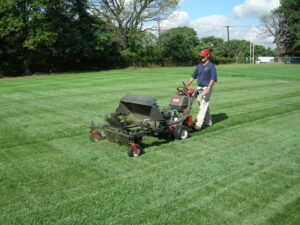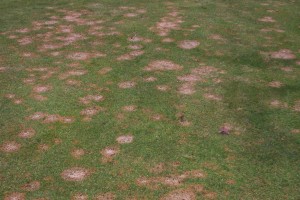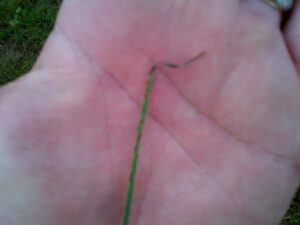The great blizzard of 2013, with all the snow and ice (and hype), has brought concerns about snow mold diseases in turfgrass. First thing first, I am glad I don’t live in Connecticut….40 inches! At any rate, snow cover provides an excellent environment for many fungi including some species of Pythium. In New Jersey we have the fungi Typhula incarnata, which causes the disease gray snow mold, and Microdochium nivale, which is the cause of pink snow mold (AKA: Fusarium patch).
Tall Fescue Varieties for Sports Turf
By Jim Murphy
 |
| The Rutgers Wear Simulator being operated on the 2006 National Tall Fescue Trial. |
Hope your winter is going well.
We recently published on the web a fact sheet update on Tall Fescue Varieties for New Jersey Sports Fields.
This fact sheet discusses the characteristics of traffic tolerance, turfgrass quality, and susceptibility to brown patch disease (caused by Rhizoctonia solani). Traffic tolerant varieties are more persistent under the combined stresses of wear and compaction, which are very common on sports turfs. The variety recommendations in this fact sheet are based on research conducted at Rutgers University on the 2006 National Turfgrass Evaluation Program (NTEP) Tall Fescue Test. Data from other locations was also used for these recommendations.
Tall Fescue Varieties for New Jersey Sports Fields
By Bradley S. Park, Sports Turf Education & Research Coordinator &
James A. Murphy, Extension Specialist in Turf Management
Cooperative Extension Fact Sheet FS1186 | December 2012
Use of tall fescue (Festuca arundinacea Schreb.) as a forage and conservation grass increased in the United States with the release of ‘Alta’ and ‘Kentucky 31’ in 1940. It has long been used for control of soil erosion along right-of-ways such as highway roadsides. By the 1960s, ‘Kentucky 31’ became more widely recognized as a useful turfgrass in the transition zone (boundary between the temperate and subtropical climates) of the United States due to its good heat tolerance and adaptation to a wide range of soil (pH, fertility and moisture) and light conditions.
- Selecting Varieties
- Purchasing Seed
- Establishment of Tall Fescue
- Maintenance of Tall Fescue for Sports Turf
- Performance of Tall Fescue Varieties
Risks to Soils and Plants from Saltwater Flooding
By Jim Murphy
As you might expect, we are receiving questions from county agents, landscapers, and property owners about saltwater flooding effects on soils and plants and the appropriate remediation. The information below may be helpful in answering these questions. (Thanks to Stephanie Murphy for pulling together a lot of this information).
This week in Turf November 15, 2012
Plant & Pest Advisory, Landscape, Nursery & Turf Edition, November 15, 2012
- Diseases of Turfgrass
- Stem and Crown Rust; Stripe Smut; Take All Patch
- Pink Snow Mold
- Announcements
- Turfgrass Expo – December 4 – 6, 2012 at Trump Taj Mahal Casino/Resort
This is a great opportunity to receive the latest turf management information from nationally renowned speakers.
For additional information, please contact Cece Peabody (973) 812-6467,
e-mail execdirector@njturfgrass.org or
Anne Diglio (848) 932-6396, e-mail diglio@aesop.rutgers.edu.
- Turfgrass Expo – December 4 – 6, 2012 at Trump Taj Mahal Casino/Resort
Gray Leaf Spot Disease
By Jim Murphy
Perennial ryegrass leaf blade damaged by gray leaf spot.
Many are planting new turf areas or re-seeding damaged areas using perennial ryegrass. Perennial ryegrass has the advantage of a fast establishment rate; a full turf cover can develop within 4 weeks.
However, you need to be aware that gray leaf spot disease…


